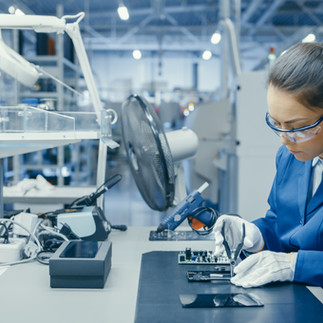Chapter 6 Input/Output in Embedded Systems
- Erika Camilleri
- Jul 7, 2021
- 4 min read
Updated: Aug 25, 2024
Discover the role of embedded systems in everyday devices and how sensors and actuators work together to automate tasks with minimal user intervention.
Glossary
Embedded System | A specialized computer designed to perform a specific task or a small set of tasks efficiently within a larger system. |
General-Purpose | A computer like a desktop or laptop that can perform a wide range of tasks through the installation of various applications and peripherals. |
Sensor | An input device that gathers data from the environment (e.g., temperature, light) and sends it to the embedded system for processing. |
Actuator | An output device that acts upon the environment based on processed data from the embedded system (e.g., motors, heaters). |
Real-World Example | An application or scenario where embedded systems are used, such as in digital cameras, traffic control systems, or industrial automation. |
What is an Embedded System?
An embedded system is a specialized computer designed to perform a specific task or a small set of tasks efficiently within a larger system. The term "embedded" highlights that the computer's components — including the processor, memory, and input/output interfaces —are integrated into a device. These components are typically programmed with limited flexibility, focusing on completing tasks with little to no user intervention. Common examples of embedded systems include dishwashers, microwaves, digital cameras, car entertainment systems, and industrial robots.
General-Purpose vs. Embedded
In the previous chapters we have focused on general-purpose computers, like desktops, and laptops which can be customised by attaching peripherals and installing applications. We do this so that our computer would be capable of performing a wide range of tasks .
A Gray Area: Smartphones, Tablets, and Smartwatches
Smartphones, tablets, and smartwatches feature a System on a Chip (SoC), which integrates various components — such as the processor, memory, and input/output interfaces — onto a single circuit. This design is comparable to that of embedded systems. However, the most sophisticated models also run operating systems that enable general-purpose capabilities, such as installing application software and connecting peripheral devices.
Introducing Sensors and Actuators
Input and output devices are not just limited to the everyday devices we've discussed so far. In embedded systems, these components often perform specific functions without direct human interaction.
In such systems, sensors are used to gather data about the environment and provide this data as input to the system. The system processes this data, which may then activate actuators to influence the environment. In this context, actuators perform the output function, as they effect changes based on the processed data. By including these components, our embedded systems can operate independently without getting tired or distracted, like people do.
Where do we use sensor and actuators?
We have listed a few use cases:
Underfloor Heating In this case temperature sensors are used to record the ambient temperature of the designated floor area, and depending on the set configuration, heating element actuators under the floor are activated to heat the area.
Home locking automation The sensor is a timing sensor and based on set configuration e.g., at 10 pm, the door lock actuator is activated to lock the door in case the user forgot to do so.
Home alarm automation In this case, a motion sensor sends signals to a processor if it detects movement, and if the security system is active, it will activate an alarm actuator to make a loud noise alerting neighbours and deterring burglars.
Real-World Examples of Embedded Systems
1. Digital Camera
A Digital Single Lens Reflex (DSLR) camera is a common example of an embedded system. The camera's embedded system manages various tasks, such as adjusting the lens (input), processing the image (processing), and displaying the image on the screen (output).
Input Components
Shutter Button: Signals the camera to capture an image.
Light Sensor: Measures the light exposure to adjust the image settings.
Buttons and Dials: Allow the user to input settings like aperture and shutter speed.
Output Components
LCD Screen: Displays the captured image.
Optical Image Stabilization: An actuator that adjusts the lens to stabilize the image and maintain focus..
Flash: Provides additional light output during low-light conditions.
In a scenario where a photographer needs to capture high-resolution images in varying light conditions, the DSLR’s light sensor (input) and adjustable flash (output) work together to ensure optimal image quality.
2. Road Traffic Control System
A road traffic control system is a sophisticated embedded system used by authorities to manage traffic flow and enhance road safety.
Input Components
Cameras: Capture real-time traffic data.
Speed Sensors: Monitor the speed of vehicles.
Inductive Loops: Detect the presence of vehicles at traffic lights.
Output Components
Traffic Lights: Control the flow of vehicles based on data input.
LED Displays: Display traffic information and alerts to drivers.
Display Panels: Alert authorities about accidents or unusual traffic patterns.
In the event of an accident, the system’s cameras (input) detect the incident, and the LED displays (output) informs drivers of alternative routes. This reduces congestion and potential secondary accidents.
3. Process Control Systems in Industry
Industrial processes often rely on embedded systems to monitor and control operations, ensuring consistent quality and efficiency.
Input Components
Temperature Sensors: Monitor the temperature of a chemical process.
Pressure Sensors: Measure the pressure within a system.
Flow Meters: Track the flow rate of liquids or gases.
Output Components
Valves: Adjust the flow of materials based on sensor input.
Heaters: Regulate the temperature within the system.
Display Panels: Provide real-time data to operators.
In a manufacturing plant, if the temperature sensor (input) detects an anomaly, the embedded system might trigger the heater (output) to adjust the temperature, maintaining product quality.























Comments